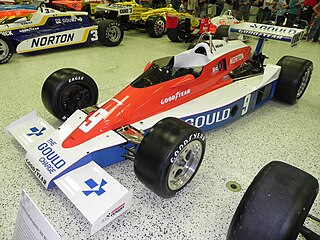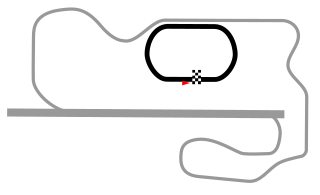Notes
See also
Works cited
Related Research Articles

The Brickyard 400 is an annual NASCAR Cup Series points race held at the Indianapolis Motor Speedway in Speedway, Indiana. The inaugural race was held in 1994 and was the first race other than the Indianapolis 500 to be held at the Indianapolis Motor Speedway since 1916. In its inaugural running, the Brickyard 400 became NASCAR's most-attended event, drawing an estimated crowd of more than 250,000 spectators. The race also paid one of NASCAR's highest purses. From 1994 to 2020, the race was held on the 2.5-mile oval, for a distance of 400 miles. The race was put on hiatus for three years (2021–2023) in favor of the Verizon 200 at the Brickyard which was run on a combined road course and run a distance of 200-mile (321.869 km). The event returned to the oval for the 2024 season.

Lucas Oil Indianapolis Raceway Park is an auto racing facility in Brownsburg, Indiana, about 10 miles (16 km) northwest of downtown Indianapolis. It includes a 0.686 mi (1.104 km) oval track, a 2.500 mi (4.023 km) road course, and a 4,400-foot (1,300 m) drag strip which is among the premier drag racing venues in the world. The complex receives about 500,000 visitors annually.

Everette Edward Carpenter, Jr. is an American auto racing driver, currently competing in the IndyCar Series for his team, Ed Carpenter Racing. He is the stepson of Indy Racing League founder Tony George.

The 60th 500 Mile International Sweepstakes was held at the Indianapolis Motor Speedway in Speedway, Indiana on Sunday, May 30, 1976. Polesitter Johnny Rutherford took the lead on lap 80, and was leading when rain halted the race on lap 103. Two hours later, the race was about to be resumed, but rain fell again. USAC officials called the race at that point, reverted the scoring back to the completion of lap 102, and Johnny Rutherford was declared the winner. Rutherford famously walked to Victory Lane, his second career Indy 500 triumph, having completed only 255 miles (410 km), the shortest official race on record. Janet Guthrie became the first female driver to enter the Indianapolis 500. However, her team was underfunded, and she experienced numerous mechanical and engine problems during the month. While she managed to pass her rookie test, and ran numerous practice laps in multiple cars, she was unable to make an attempt to qualify. She would return with a successful effort a year later in 1977.

The 61st 500 Mile International Sweepstakes was held at the Indianapolis Motor Speedway in Speedway, Indiana on Sunday, May 29, 1977. Considered one of the most historically significant editions of the Indianapolis 500, several sidebar stories complemented the unprecedented accomplishment of race winner A. J. Foyt. Foyt became the first driver to win the Indianapolis 500 four times. As of 2023, Foyt's record has been tied by Al Unser Sr., Rick Mears and Hélio Castroneves, but still stands as an Indy 500 record. Foyt's victory is also the last time the winning car was built entirely within the United States.

The 62nd 500 Mile International Sweepstakes was held at the Indianapolis Motor Speedway in Speedway, Indiana on Sunday, May 28, 1978. Danny Ongais dominated the early stages of the race but eventually dropped out with a blown engine. Al Unser Sr. dominated the second half, and held a large lead late in the race. However, Unser bent the front wing of his Lola during a pit stop on lap 180, causing his handling to go away over the final twenty laps. Second place Tom Sneva charged to catch Unser's crippled Lola but came up 8 seconds short at the finish line – the second-closest finish in Indy history to that point. Unser held off the challenge, and became a three-time winner of the 500. It was Al Unser's third Indy victory in the decade of the 1970s, and the fifth of nine overall victories by the Unser family.

The 63rd 500 Mile International Sweepstakes was held at the Indianapolis Motor Speedway in Speedway, Indiana, on Sunday May 27, 1979. Second-year driver Rick Mears took the lead for the final time with 18 laps to go, and won his first of four Indianapolis 500 races. It was also Mears' first of a record six Indy 500 pole positions. Brothers Al and Bobby Unser combined to lead 174 of the 200 laps, but Al dropped out around the midpoint, and Bobby slipped to 5th place at the finish nursing mechanical issues. It was also Roger Penske's second Indy 500 victory as a car owner.

Joe Saldana is an American former open-wheel racing driver.

The Freedom 100 was an automobile race held annually at the Indianapolis Motor Speedway in Speedway, Indiana, as part of the Indy Lights. The event was a support race for the IndyCar Series Indianapolis 500, and since 2005, it was held on the Friday preceding the Indianapolis 500, the day known as "Carb Day".

The Milwaukee Mile in West Allis, Wisconsin has hosted American open-wheel car racing events dating back to 1937. The AAA Contest Board, USAC, CART, Champ Car World Series, and the IndyCar Series have all sanctioned races at the facility. The Milwaukee Mile has a long history of Championship/Indy car racing, and for many years, traditionally held a race the weekend after the Indianapolis 500.
The Automotive Racing Products Turkey Night Grand Prix is an annual race of midget cars. It is the third oldest race in the United States behind the Indianapolis 500 and the Pikes Peak International Hill Climb. It has been held on Thanksgiving night most years since 1934, where it was founded by Earl Gilmore at his Gilmore Stadium in Los Angeles. It stayed at this location until 1950. Since that time it has been held at various southern California race tracks. Since 1955, the race has been promoted by J. C. Agajanian and later his descendants, currently by son Cary. Traditionally a dirt track event, it has sometimes been on asphalt during the turn of the 21st century, although it returned to dirt in 2012. The feature race was held over 98 laps in the modern era, the same number that Agajanian used for his racecars.

Terre Haute Action Track is a half-mile dirt racetrack located at the Vigo County, Indiana, fairgrounds on U.S. Route 41 along the south side of Terre Haute, Indiana. The track hosts annual United States Automobile Club (USAC) midget car, sprint car and Silver Crown events. Notable drivers that have competed at the track include A. J. Foyt, Jeff Gordon, Parnelli Jones, and Tony Stewart. The track has held events sanctioned by USAC, its predecessor American Automobile Association (AAA), and the World of Outlaws.

The Dave Steele Carb Night Classic is a United States Auto Club dirt track car race held near Indianapolis, Indiana, United States, which takes place in late May before the Indianapolis 500 at the nearby Indianapolis Motor Speedway. Over its history, the event has been held at several different short tracks in Indiana, but since 1980, it has permanently been hosted at Lucas Oil Indianapolis Raceway Park in Brownsburg, Indiana. The event has long been considered one of the Indianapolis 500 traditions, along with the Hoosier Hundred and Little 500, which are also held over the same weekend at different venues in Indiana. Over the course of its history, numerous Indy 500 drivers have competed in the Night Before the 500, some winning.

Due to the longevity of the Indianapolis 500, numerous traditions surrounding the race have developed over the years. Traditions include procedures for the running of the race, scheduling, and pre-race and post-race festivities. For many fans, these traditions are an important aspect of the race, and they have often reacted quite negatively when the traditions are changed or broken.
The 1981–82 USAC Championship Car season consisted of six races, beginning in Speedway, Indiana, on May 24, 1981, and concluding at the same location on May 30, 1982. The USAC National Champion was George Snider. The season included two Indianapolis 500 races. The 1981 winner was Bobby Unser, while the 1982 winner was Gordon Johncock. The schedule included dirt courses for the first time since 1970.

The Grand Prix of Indianapolis, also known as the IndyCar Grand Prix is an IndyCar Series race held on the combined road course at the Indianapolis Motor Speedway in Speedway, Indiana. The race was first held in 2014 and is typically held on a Saturday in mid-May, two weekends prior to the Indianapolis 500. The race serves as a lead-in to the Indianapolis 500, and includes support races from the Road to Indy, including Indy NXT, USF Pro 2000 Championship and USF2000 Championship.

The state of Indiana is home to two major professional sport franchises, and a number of college sports teams. Indiana is also prominent in auto racing.
The 2017 USAC Silver Crown Champ Car Series presented by Traxxas season is the 46th season of the USAC Silver Crown Series. The series began with the Sumar Classic at the Terre Haute Action Track on April 2, and will end with the 4 Crown Nationals at Eldora Speedway on September 23. Chris Windom entered the 2017 season as the defending champion. Kody Swanson won the 2017 season championship driving for DePalma Motorsports in the #63 Maxim / Hampshire Chevrolet.

Kody Mykel Swanson is an American professional sprint car racing driver. He is a seven-time USAC USAC Silver Crown Series champion in 2014, 2015, 2017, 2018, 2019, 2021 and 2022, plus a three-time Little 500 winner. Swanson is currently the all-time wins leader in Silver Crown with 40.

The 1981 Pocono 500, the 11th running of the event, was held at the Pocono Raceway in Long Pond, Pennsylvania, on Sunday, June 21, 1981. Branded as the 1981 Van Scoy Diamond Mine 500 for sponsorship reasons, the race is notable as the final win for all-time IndyCar race winner, A. J. Foyt. It is also notable for its role in the confrontation between separate Indy car racing sanctioning bodies, USAC and CART, as well as the inclusion of older indycars and 8 front-engined dirt cars from the USAC Silver Crown Series in the race.
References
- 1 2 3 4 5 "Hoosier Hundred Is Rich In Racing History". National Speed Sport News. May 2013. Retrieved 2013-06-24.
- ↑ "Hoosier 100 - Event Info". Sprint Source. 2013-05-22. Retrieved 2013-06-24.
- ↑ "Hoosier Lottery Grandstand". Indiana State Fair. Retrieved 2013-06-24.
- 1 2 3 4 Cox, Stephen (2013-05-08). "Five Minutes with Hoosier Hundred Promoter Bob Sargent". Motor Sports News. Archived from the original on 2013-06-23. Retrieved 2013-06-24.
- 1 2 3 4 "Hoosier Hundred retrospective". MotorSport.com. 2006-05-16. Retrieved 2013-06-24.
- 1 2 "Hoosier Hundred Retrospective". IndianaRacing.Net. 2007-05-21. Retrieved 2013-06-24.
- ↑ "Indy 500 Flavor at Foyt's "Hulman-Hoosier Hundred"". The Auto Channel. 1998-05-19. Retrieved 2013-06-24.
- ↑ "'World of Outlaws' races move to July". Tribune-Star (Terre Haute, IN). 2019-11-25. Retrieved 2019-12-03.
- ↑ Paul, Brandon. "Hoosier Hundred Will Return As A Pavement Race In 2023". Floracing. Flosports. Retrieved 2022-12-08.
- ↑ Murray, Richie. "2023 USAC Silver Crown Schedule Revealed!". USAC Racing. United States Auto Club. Retrieved 2022-12-08.